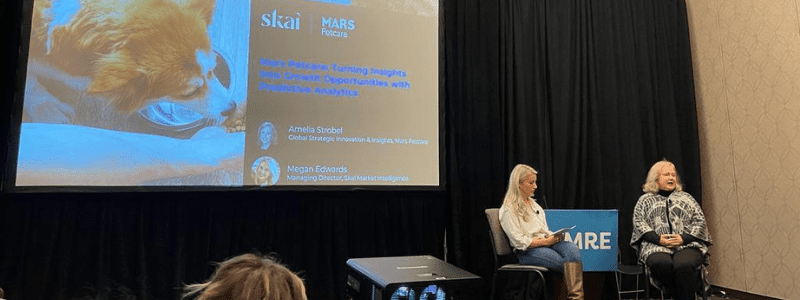
For more than 20 years, The Market Research Event (TMRE) has hosted thousands of insights professionals for annual gatherings focused on the latest and greatest advancements in insights and consumer research.
This year, attendees gathered both in person in Nashville and via streaming sessions online to explore what’s next for fast-paced, cutting-edge businesses: moving beyond insights and toward foresight to keep predictions about the future at the heart of decision-making.

Skai interview’s Amelia Stobel at TMRE
Who better to share her experience than Mars Petcare’s Amelia Strobel, the driving force behind developing a transformative and industry-leading foresights capability within the organization?
Five questions with Amelia Strobel

A well-regarded speaker, she has presented on a variety of topics at AMA, ARF, IIR, TMRE, and other industry conferences, and she has been listed in Shopper Marketing Who’s Who. Amelia received both her BA in History and MBA from Vanderbilt University. She resides in Nashville, TN with her husband and two daughters where she enjoys hiking, discovering new restaurants, listening to live music, and volunteering
We spoke with Amelia about her experience transforming Mars into a foresight-driven organization:
Mars Petcare is one of the few organizations with a well-established foresight team. How has that transformation unfolded over the years?
We have been moving from an insights organization to a foresight organization with tools we’ve put in place—like Skai—that have helped us upskill talent and automate the tracking of marketplace signals so we can activate and act on them as quickly as possible. We were able to make this jump by democratizing data across the organization; Skai has been instrumental in this effort.
Working with Skai, we created playbooks that everyone at Mars can access. These playbooks have made it possible for us to answer senior leaders’ questions in record time. Depending on the topic and the level of detail needed, we can either go directly to the Skai platform and answer the question within minutes, or do a deep dive over a week or two. This is significantly faster than what we’ve been able to do in the past.
Here’s a real example. Royal Canin, one of our pet food brands, asked about consumer interest in rabbit protein as an ingredient. Within an hour, I was able to access consumer conversations and put together a topline deck with my recommendations on what Royal Canin should consider.
This speed and agility has been a key component of our data-backed strategies.
How do you manage a foresight-driven team structure with both centralized insights teams and broader business team collaboration? How do you attract talent in the predictive analytics and insights space considering all the competition from tech giants?
Mars is a relationship-driven company. Mentors encourage you to have a network of advisors in addition to your business partner relationship which helps strengthen community.
Mars also has a preference for keeping decision-making close to the consumer and the customer, so we run both a centralized, global insights team and insights teams within each one of the markets or regions, depending on the structure. Because we’re so relationship-driven, it’s really important to keep open lines of communication and share best practices with each other. We’ve embedded different formal and informal forums that keep our communications structured and organized in a way that works for us.
As far as attracting talent goes, we face the same challenges that other CPG brands face. Over the last few years, we’ve been building internal advanced data analytics capabilities by hiring data scientists into the Mars world. We have also created roles within the marketing organization for people with these skills. For some of the data scientists, a rotation in marketing is a good development role so that they learn more about the business. That’s because the data scientists we are hiring don’t necessarily have pet business experience, such as running and growing a brand.
So this becomes a win-win—they get growth and development opportunities they can’t typically get elsewhere, and Mars gets well-rounded employees that really understand the business. While competition for data scientists is intense, we hope that Mars’ principles, purpose, and people-first approach are attractive to highly sought-after talent.
We’ve seen a lot of marketing teams go through full transformations to start leveraging more insights within their strategies. It sounds like Mars is innovating by rotating data scientists into marketing roles; what else is Mars doing on the journey to bringing insights and foresights to the marketing team?
In addition to a Mars-wide move from insights to foresight, we’ve also put a lot of emphasis on digital and data transformations for the marketing team. The role of marketing has shifted, and it’s required if you are a marketer to understand the strategic and tactical pieces of digital. So we’re pushing digital transformation in marketing through training, education, and on the job experiences.
The other major piece of our data transformation is around purpose and “mutual value” for brands and pet parents. About five years ago we identified that purpose marketing was becoming a trend, particularly among younger consumers. They now look for brands to do more, to have a purpose that reflects their values vs. just being a product or service.
This has been a huge shift for us as we’ve discovered how data can inform both of those from a metrics perspective as well as the formulation of strategies and plans.
Mars’ purpose-driven business strategies are really smart, tying philanthropic giving to areas that support brand growth. How has Mars moved toward that purpose-driven strategy?
First we look at the brand essence—what the brand stands for. Then we assess the role of the brand for the portfolio and category. From there, we do extensive work from an insight and foresight perspective to understand the steering insights and jobs to be done, the value proposition we can bring that’s beyond the product.
For example, with Pedigree, we’ve been running an adoption campaign for many years. Adoption makes a lot of sense because Pedigree is one of the brands that’s a gateway to the category. And if you think about how to grow the category, it’s through pet adoption. The purpose is to help dogs find loving homes, which is an inspirational vision.
Over time, we’ve become better at understanding what the metrics are that we need to put in place to see how the purpose is helping the world—whether we’re moving the needle on adoptions—and how the purpose is helping the brand from a perception and sales and marketing perspective. Now we’re looking at the rest of our portfolio to see how to do this for more brands.
There’s a big difference between having an insight and predicting the future. How do you separate a trend from a fad? How do you decide which predictions to act on?
You can make money off a fad if you know it’s a fad. And you can also make a lot of money if you can correctly identify a long-lasting trend and invest in that growth. What’s key is understanding the difference between the two.
We often look at trends in the human world because they may cascade into the pet sector; that’s a huge indicator for us. Some of the trends we see right now in pet nutrition—like immunity and digestive health—are actually long-standing trends in the human health space.
As far as fads go, I have a great example of a well-managed response to a fad from a previous role where we wanted to quickly launch a line of low-carb snacks to capitalize on the low-carb phenomenon that was happening. We knew it would be a fad, so we created a simulated test market to quantify the size of the opportunity. Our metrics told us not to launch.
We decided to launch anyway because it was a huge short-term opportunity, but we convinced the organization not to over-invest or over-deliver in raw materials and inventory knowing that this was a product that would be short-lived. It ended up as a win-win-win; customers got what they desired, shareholders saw stock prices rise and never come back down, and internally we managed this so well that it was viewed as a success despite the fact that the product was delisted shortly thereafter. And that is all because we had the foresight to know that this was not going to be a longer term success; by managing a fad as a fad, we set and met expectations.
Looking ahead, we want to make sure we were considering what other surprises the future holds as we realized that nobody was talking about the next 5-10 years in pet care. So internally, we commissioned a study, Pet Family of the Future 2030, taking an outside-in approach to help us determine which human behaviors could exist in 2030 and how that could impact the category from a challenge perspective as well as an opportunity perspective. It’s been well received so far and we’re continuing to cascade it throughout the organization.
Interested to see how Skai can help your brand transition from insight to foresight? Contact us for a personalized demo.






